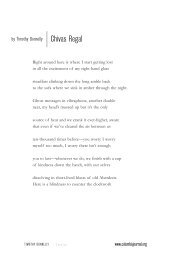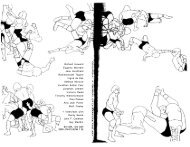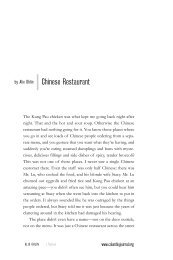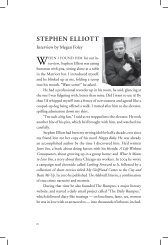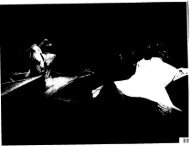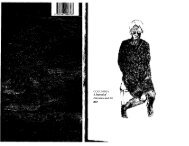Issue 27 - Columbia: A Journal of Literature and Art
Issue 27 - Columbia: A Journal of Literature and Art
Issue 27 - Columbia: A Journal of Literature and Art
Create successful ePaper yourself
Turn your PDF publications into a flip-book with our unique Google optimized e-Paper software.
98<br />
always looked at curating as collaborative, thinking <strong>of</strong> a theme <strong>and</strong><br />
finding artists who fit that criteria. I'm usually inspired by one<br />
person <strong>and</strong> it springboards into different ideas. I see associations.<br />
Clues from one person lead to another person.<br />
C: Did that happen with your current show?<br />
BK:Yes, it was pretty much Michael Ashkin <strong>and</strong> Brad Kahlhamer,<br />
dealing with the l<strong>and</strong>scape <strong>and</strong> the environment in a certain way.<br />
I think <strong>of</strong> them as more or less creating their specific worlds <strong>and</strong> then<br />
populating them. Roxy Paine is much more ironic. They seem to<br />
be surrounding themselves, it's their way <strong>of</strong> underst<strong>and</strong>ing their<br />
world by surrounding themselves with these things.<br />
Untitled, Ellen Berkenblit<br />
COURTESY OF BRONWYN KEENAN GALLERY, NEW YORK<br />
C: What is your responsibility as the curator?<br />
BK: You have to show work in the right context. There's nothing<br />
worse than a show where everything is just put up on the wall, <strong>and</strong><br />
there's a certain vibe <strong>of</strong> "everything must go," like a warehouse.<br />
The purpose <strong>of</strong> a group show is to have a theme, but not to be<br />
obvious. I don't like themes that hammer you over the head.<br />
C: You've described your role as one <strong>of</strong> giving artists a "home."<br />
Does that metaphor extend to make you <strong>and</strong> the exhibiting artists<br />
a family?<br />
BK: That happens at small galleries like mine, but I don't think at<br />
the large, major ones. My purpose is also to find artists. I shownew<br />
artists, people who haven't been exposed, <strong>and</strong> I really like<br />
taking new people on. There's only so much you can do <strong>of</strong> that,<br />
but I really like it.<br />
C: Does showing together spur artists to work together?<br />
BK: Definitely. I hear the artists in my show talking about<br />
collaborating, not just showing together but actually doing.<br />
C: Like a bloodline.<br />
BK: Yeah, exactly.<br />
C: What is your vision as a gallery director in New York City,<br />
specifically?<br />
BK: Everything changes so quickly. When I started (last year), I<br />
thought I didn't want to represent particular people, I wanted to<br />
do group shows <strong>and</strong> show a lot <strong>of</strong> different work by a lot <strong>of</strong><br />
different artists. Then I started to discover that there's only so<br />
much that I really connect to, <strong>and</strong> I want to work with some<br />
people long term, not have it slip away.<br />
C: How much <strong>of</strong> your work is affected by being in New York?<br />
BK: You have access to the artists. They're here. You don't have<br />
problems just getting the work. New York is the only place I'd<br />
want to be.<br />
C: You worked at a gallery in London. How did that affect your<br />
perspective here?<br />
BK: Young artists in London are really responding to Damien<br />
Hirst <strong>and</strong> the whole white cube crowd. It's very different from<br />
what's happening here. They're using different materials, <strong>and</strong> in





